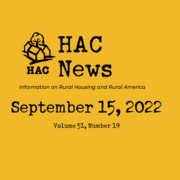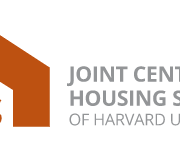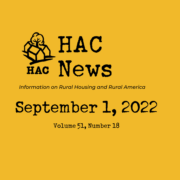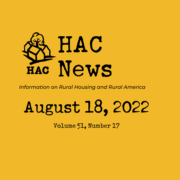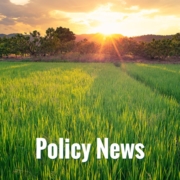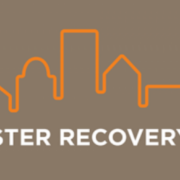TOP STORIES
Continuing resolution needed to keep government running
Before federal fiscal year 2022 ends on September 30, Congress will need to pass a continuing resolution holding most federal funding at current levels. The Biden administration requested a number of “anomalies” – variations from FY22 funding – in a CR, including added funding for CDBG-DR and FEMA disaster relief. A CR could last until mid-December, but nothing has been decided yet.
Poverty increased for rural residents and seniors in 2021, Census Bureau reports
On September 13 the Census Bureau released analyses of national-level income, poverty, and health insurance statistics for 2021, exploring year-over-year changes and other long-term trends. Income in the United States: 2021 did not report a statistically significant change in median household incomes, though the $53,750 median income outside metro areas is considerably lower than the $73,823 income in metro areas. Poverty in the United States: 2021 did not report a statistically significant change in year-over-year official poverty rates for the nation, but did note a statistically significant increase for places outside metro areas from 14.1% in 2020 to 15.0% in 2021, representing approximately 377,000 more people in poverty. There was also a statistically significant increase in the poverty rate for people age 65 or older and, given that rural populations tend to be older than others, that likely accounts for some part of the increase in the rural poverty rate.
Webinar to focus on preparing your organization for disaster
On September 21 HAC will present Preparing Your Organization for Disaster: A Guide to Rural Resilience. As disasters become more frequent, organizations will need to make themselves ready to address the associated housing challenges in their communities. Join HAC during National Preparedness Month to hear from local organizations that have experienced natural disasters from fires to flooding. Discover the value of being prepared and learn how to make your organization disaster resilient. We will also showcase our Rural Resilience in the Face of Disaster website and offer tools to help prepare your organization for disaster.
September is National Preparedness Month
FEMA has posted disaster preparedness resources online.
September is National Recovery Month
President Biden’s proclamation of September as National Recovery Month discusses the substance use disorder epidemic, affecting more than 20 million Americans, highlighting the amplified effects in rural communities. The president also mentions the importance of secure and reliable housing in the recovery process.
September 15 – October 15 is Hispanic Heritage Month
The federal government’s website for the observance states, “We celebrate Hispanic Heritage Month to recognize the achievements and contributions of Hispanic American champions who have inspired others to achieve success.”
RuralSTAT
During 2021, 6.7% of households living outside metro areas had low food security (difficulty providing enough food for all household members) and 4.1% had very low food security (reduced food intake by some members because of limited resources), slightly higher than the national rates of 6.4% and 3.8%. Source: USDA Economic Research Service.
OPPORTUNITIES
Healthy homes funding offered
State, local, and tribal governments, nonprofits, and consortia can use HUD’s Healthy Homes Production Grant Program funds to eliminate housing-related health and safety hazards in privately owned low-income rental or owner-occupied housing, conduct public education and outreach activities, build local capacity, and more. Applications are due October 18. For more information, contact Sacsheen Scott, 202-402-4370.
REGULATIONS AND FEDERAL AGENCIES
Housing aid won’t impact immigrants’ legal status under final “public charge” rule
U.S. immigration law provides that a noncitizen can be denied legal resident status if they are deemed likely to become a “public charge.” Until 2019, longstanding policy focused these determinations on receipt of cash assistance or long-term institutionalization. The Trump administration broadened the rule in 2019 to include non-cash assistance such as federal housing aid and Medicaid. The Biden administration cancelled that rule and resumed using the previous guidance in 2021 and has now issued its own final rule, which focuses on cash supports and takes effect December 23. The only programs considered in a public charge determination will be Supplemental Security Income, Temporary Assistance for Needy Families, state, tribal, or locally funded cash assistance for income maintenance, and long-term institutional care paid for by Medicaid. Information in nine languages is posted by the Protecting Immigrant Families Coalition.
USDA multifamily budgeting information posted, service coordinators now a permitted expense
USDA Rural Development has posted a recording and slides from a training on proposed budgets for borrowers with multifamily housing loans, who must submit annual proposed budgets before their projects’ fiscal years begin. The agency also reminds borrowers that for FY2023, service coordination is a permitted budget expense for RD properties. Service coordinators help residents connect with services available in their community; RD suggests using the resources and information available from the American Association of Service Coordinators. For more information, contact the RD Servicing Specialist assigned to the specific property.
Lease-up reserve reduced for Section 538 rental housing guarantees
Effective immediately, USDA has lowered the amount of the lease-up reserve required for the Section 538 Guaranteed Rural Rental Housing Program. To cover costs while units are being leased to their initial occupants, borrowers are required to provide cash for the lease-up reserve in addition to their initial operating and maintenance contributions. The agency calculates the new calculation will save borrowers an average of around $100,000 per transaction. For more information, contact Tammy Daniels, USDA, 202-720-0021.
Comments requested on updated FEMA guide
FEMA seeks comments by September 23 on an update to its Hazard Mitigation Assistance Program and Policy Guide. The Hazard Mitigation Grant Program funds state, local, tribal, and territorial governments to develop hazard mitigation plans and rebuild in a way that reduces future disaster losses. For more information, contact Jennie Orenstein, FEMA, 202-212-4071.
EVENTS
Senate subcommittee continues review of USDA rural housing programs
The Senate Subcommittee on Housing, Transportation, and Community Development will hold a hearing September 20 titled Examining the U.S. Department of Agriculture’s Rural Housing Service: Stakeholder Perspectives. This session follows one in May that featured Xochitl Torres Small, USDA’s Under Secretary for Rural Development.
Rural rental preservation policy webinar scheduled
Enterprise Community Partners’ Southeast Rural Rental Preservation Academy will hold a National Policy Summit on October 5 looking at how government, philanthropy, housing providers, and advocates can work together to preserve affordable rental homes in rural communities. Speakers will include Farah Ahmad, USDA Deputy Under Secretary for Rural Development.
Listening session to consider Federal Home Loan Bank system
The Federal Housing Finance Agency is conducting a comprehensive review of the Federal Home Loan Bank system. The process will include two public listening sessions and a series of regional roundtable discussions to consider and evaluate the FHLBanks’ role or potential role in addressing housing finance, community and economic development, affordability, and other related issues. The kick-off event and first listening session, FHLBank System at 100: Focusing on the Future, will be held on September 29, in-person in Washington, DC, and virtually. Written comments can also be submitted through October 21.
PUBLICATIONS AND MEDIA
Child poverty dropped more than half from 1993 to 2019
Child poverty in the U.S. fell from 28% in 1993 to 11% in 2019, according to a new study using the Supplemental Poverty Measure, which accounts for government aid and adjusts for local living costs, unlike the Official Poverty Measure. Still, over 8 million children live in poverty and, although the poverty rate fell for all racial and ethnic groups, Black and Hispanic children are far more likely than white children to be poor. (Data for Native American children were not robust enough to be included.) Lessons from a Historic Decline in Child Poverty, a study by Child Trends and the New York Times, found the drop was attributable to factors including lower unemployment, increased labor force participation among single mothers, increases in state-level minimum wages, and especially the expansion of government aid. The report includes a set of recommendations to further reduce child poverty.
Data released on sheltered homelessness in 2019 and 2020
Part 2 of HUD’s Annual Homeless Assessment Report to Congress, Estimates of Homelessness in the United States, provides national-level estimates of people experiencing sheltered homelessness during 2019 and 2020. It reports demographics and patterns of shelter use, including not only emergency shelters, safe havens, and transitional housing programs, but also permanent supportive housing and rapid re-housing rent subsidies. The data shows disproportionately low rates of shelter use in rural places for all demographic categories, but those findings seem likely to reflect the lower availability of shelters there rather than lower levels of need.
HUD offers important funding for rural and unsheltered homelessness
Kansas Reflector reports on the importance for rural places of HUD’s currently open initiative to address rural homelessness. Rural areas have few homeless programs and services and, while these areas may have vacant housing, it may not be safe to live in. Continuums of Care must apply for the available funding by October 20. For more information, visit HAC’s post about this initiative.
New maps show climate change risks in U.S.
- A Climate Mapping for Resilience and Adaptation portal compiles data from several federal agencies into a live dashboard to help communities see climate change hazards for the present and the future. The tool aims to help communities track real-time impacts and access federal resources for long-term planning.
- Hazardous heat is mapped by First Street Foundation, joining flood and fire dangers on the Risk Factor site, which provides property-level data about current and future dangers.
University students help rural town compile housing data
An article on UGA Today titled Students Help Gather Housing Data for Rural Community describes practicum work by University of Georgia Master of Public Administration candidates helping the city of Lyons perform a property assessment. The students got real life experience collecting data and turning it into useful information. Lyons, in turn, can use the information in planning and in applying for funds to address housing need.
HAC
HAC seeks Housing Specialist – Native American Communities and Community Placemaking Manager
- The Housing Specialist – Native American Communities is responsible for providing direct technical assistance, coaching, and training to tribal communities, tribal housing departments, tribal housing authorities, and nonprofit organizations serving tribal communities. Travel is required. This position is eligible for telecommuting.
- The Community Placemaking Manager helps rural residents use their unique artistic and cultural resources to guide local development and shape the future design of their communities. The manager will cultivate the capacity of partner organizations and local communities, facilitate peer-to-peer learning engagements, manage day-to-day program functions and activities, communicate program success, and prepare funding applications. Travel is required. This position is eligible for telecommuting.
Need capital for your affordable housing project?
HAC’s loan fund provides low interest rate loans to support single- and multifamily affordable housing projects for low-income rural residents throughout the U.S. and territories. Capital is available for all types of affordable and mixed-income housing projects, including preservation, new development, farmworker, senior and veteran housing. HAC loan funds can be used for pre-development, site acquisition, site development, construction/rehabilitation and permanent financing. Contact HAC’s loan fund staff at hacloanfund@ruralhome.org, 202-842-8600.
Please note: HAC is not able to offer loans to individuals or families. Borrowers must be nonprofit or for-profit organizations or government entities (including tribes).
Want to reprint a HAC News item?
Please credit the HAC News and provide a link to HAC’s website. Thank you!



